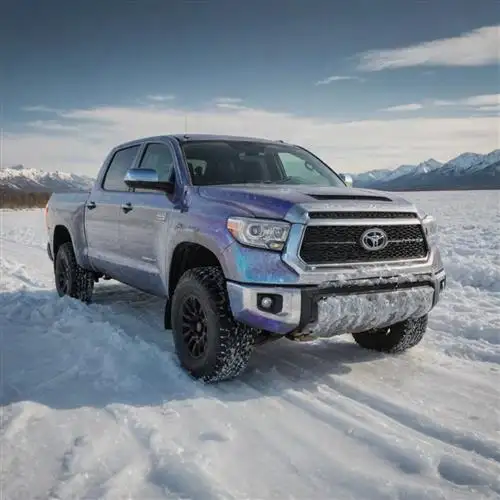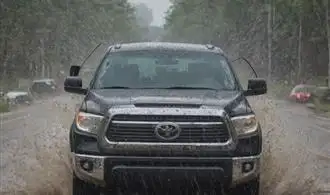
Changing the Oil and Filter
Maintaining your Toyota Tundra's engine health is crucial for its longevity and peak performance. At the heart of this maintenance routine is the regular oil and filter change. This seemingly simple task holds the key to unlocking your Tundra's full potential. Let's dive into the details and explore the steps to ensure your Tundra is running smoothly.
First and foremost, it's essential to use the recommended oil grade specified by Toyota for your Tundra model. Consult your owner's manual or speak with a trusted mechanic to determine the appropriate oil viscosity. Using the correct oil not only protects your engine but also ensures optimal fuel efficiency and emissions control.
When it comes to the oil change interval, Toyota generally recommends changing the oil every 5,000 to 10,000 miles, or every six to twelve months, whichever comes first. However, it's important to note that this can vary depending on your driving conditions and style. If you frequently tow heavy loads, engage in off-road adventures, or operate in extreme temperatures, you may need to change the oil more frequently to maintain the engine's optimal performance.
The oil filter plays a crucial role in the overall oil change process. It's designed to trap contaminants and debris, preventing them from circulating through the engine and causing wear and tear. When changing the oil, be sure to replace the filter as well. Consult your owner's manual or speak with a professional to ensure you're using the correct filter for your Tundra model.
Rotating the Tires
Maintaining the health and longevity of your Toyota Tundra's tires is crucial for ensuring a smooth, safe, and fuel-efficient ride. One of the essential practices in this regard is tire rotation, a simple yet effective task that can extend the lifespan of your tires and improve your vehicle's overall performance. In this section, we'll dive deep into the benefits of rotating your Tundra's tires and provide you with a step-by-step guide on how to do it properly.
The primary reason for rotating your tires is to achieve even wear across all four tires. Due to the different weight distribution and steering patterns, the front and rear tires on your Tundra will wear at different rates. By regularly rotating the tires, you can help ensure that they wear evenly, which not only extends their lifespan but also enhances the vehicle's handling, stability, and fuel efficiency.
When it comes to the frequency of tire rotation, most manufacturers recommend doing it every 5,000 to 8,000 miles. However, it's important to consult your Tundra's owner's manual for the specific recommendation, as the optimal rotation interval can vary based on factors such as driving conditions, terrain, and your personal driving habits.
- Park your vehicle on a level surface and engage the parking brake.
- Loosen the lug nuts on all four tires, but do not remove them yet.
- Lift the front of the vehicle using a floor jack, ensuring it's securely supported by jack stands.
- Remove the front tires and move them to the rear positions, maintaining the same side (e.g., front-left to rear-left).
- Install the rear tires on the front positions.
- Repeat steps 3-5 for the rear tires, moving them to the front positions.
- Torque the lug nuts to the specified value in a star or crisscross pattern.
- Lower the vehicle and recheck the lug nut torque.
It's important to note that if your Tundra has a full-size spare tire, you should include it in the rotation pattern as well. This will help ensure even wear across all five tires and maintain a consistent handling feel.
Inspecting and Replacing the Brakes
Maintaining the brakes on your Toyota Tundra is crucial for ensuring the safety and performance of your vehicle. Regular inspections and timely brake replacements can extend the life of your braking system and provide you with peace of mind on the road. In this section, we'll dive into the process of inspecting and replacing the brakes on your Tundra.
When inspecting your Tundra's brakes, start by visually examining the brake pads and discs. Look for any signs of wear, such as thin pads or uneven disc surfaces. If the brake pads have less than a quarter-inch of material remaining, it's time to replace them. Additionally, check for any cracks, grooves, or scoring on the brake discs. If the discs are warped or severely damaged, they'll need to be replaced as well.
To inspect the brake calipers, gently squeeze the caliper to ensure it's moving freely and the piston is retracting properly. If the caliper is sticking or the piston is not moving smoothly, it may need to be serviced or replaced. Remember to also check the condition of the brake hardware, including the caliper slides, pins, and bushings, to ensure they're in good working order.
When it's time to replace the brake pads, start by loosening the lug nuts on the wheel and removing the tire. Then, remove the brake caliper and slide it out of the way, taking care not to let it hang by the brake hose. Carefully remove the old brake pads and clean the caliper mounting surface to ensure a proper fit for the new pads.
Before installing the new brake pads, apply a thin layer of brake lubricant to the back of the pads and the caliper sliding surfaces. This will help reduce noise and ensure smooth operation. Carefully insert the new pads and reassemble the caliper, making sure it's securely in place.
If you're also replacing the brake discs, the process will be more involved. You'll need to remove the caliper, the brake pads, and then the brake disc itself. Be sure to clean the hub surface and install the new disc, making sure it's properly seated and secured.
Once the new brake components are in place, it's essential to properly bedding-in the brakes. This process involves several gentle stops and brake applications to allow the new pads and discs to form a proper surface contact. Follow the manufacturer's recommended bedding-in procedure to ensure optimal braking performance and longevity.
Flushing the Coolant System
Maintaining the coolant system in your Toyota Tundra is crucial for its longevity and performance. Regular coolant flushes can help prevent issues like overheating, engine damage, and premature wear of key components. Here's how you can flush your Tundra's coolant system and ensure it's running at its best.
First and foremost, it's important to use the correct coolant type specified by Toyota for your Tundra model. Using the wrong coolant can lead to compatibility issues and potentially cause more harm than good. Consult your owner's manual or speak with a Toyota dealership to determine the right coolant for your vehicle.
When flushing the coolant system, you'll want to start by draining the old coolant. This can be done by locating the drain plug, typically located at the bottom of the radiator or engine block, and opening it to allow the old coolant to drain out. Be mindful of any hot coolant, as it can cause burns if not handled properly.
Once the system is drained, you can begin the flushing process. Use a garden hose to fill the radiator with fresh, clean water and let it circulate through the system. You may need to repeat this process a few times until the water runs clear, indicating that the old coolant has been fully flushed out.
It's also a good idea to inspect the condition of the radiator hoses and clamps during the flushing process. Look for any signs of wear, cracks, or leaks, and replace any components that appear to be in poor condition.
After the flushing is complete, you can refill the system with the appropriate coolant mix. Be sure to follow the manufacturer's recommendations for the correct coolant-to-water ratio. Overfilling or using the wrong mixture can lead to problems.
Replacing the Air Filter
Maintaining the air filter in your Toyota Tundra is a crucial step in ensuring its optimal performance and longevity. The air filter plays a vital role in keeping contaminants, debris, and dust from entering the engine, protecting it from premature wear and tear. In this section, we'll dive into the steps involved in replacing the air filter and share valuable insights to help you tackle this task with confidence.
First and foremost, it's important to understand the recommended replacement interval for your Tundra's air filter. Toyota generally advises replacing the air filter every 12 months or 12,000 miles, whichever comes first. However, this may vary depending on your driving conditions and the specific recommendations in your owner's manual. In areas with high dust or pollution levels, you may need to replace the filter more frequently.
When it's time to replace the air filter, the process is relatively straightforward. Here's a step-by-step guide to help you get the job done:
- Locate the air filter housing, typically found in the engine compartment. Consult your owner's manual if you're unsure of its exact location.
- Carefully open the air filter housing by releasing any clips or fasteners that secure the cover. Take note of how the cover is oriented to ensure proper reinstallation.
- Remove the old air filter and inspect it. If it appears heavily soiled, clogged, or damaged, it's time for a replacement.
- Clean the interior of the air filter housing using a clean, dry cloth. Remove any debris or buildup that may have accumulated.
- Insert the new air filter, ensuring it fits snugly and aligns correctly with the housing.
- Replace the cover and secure it back in place, making sure all clips or fasteners are properly engaged.
When purchasing a replacement air filter for your Tundra, it's crucial to select the correct part that meets or exceeds the manufacturer's specifications. Using a high-quality, OEM-approved air filter will not only ensure optimal engine performance but also maintain your vehicle's warranty coverage.
Additionally, it's a good practice to visually inspect the air filter during routine maintenance checks. If you notice any signs of damage, such as tears, holes, or excessive dirt buildup, it's best to replace the filter immediately to prevent any potential issues.
















